Coca-Cola's New Coke: A Strategic Failure
VerifiedAdded on 2020/03/28
|12
|2752
|120
AI Summary
This assignment examines the failed launch of Coca-Cola's 'New Coke' in 1985, analyzing the company's strategic decisions and the lack of a robust information system. It explores how these factors contributed to the product's downfall and the loss of market share. The analysis delves into alternative strategies that could have mitigated the failure, highlighting the importance of market research, customer feedback, and effective planning in business.
Contribute Materials
Your contribution can guide someone’s learning journey. Share your
documents today.
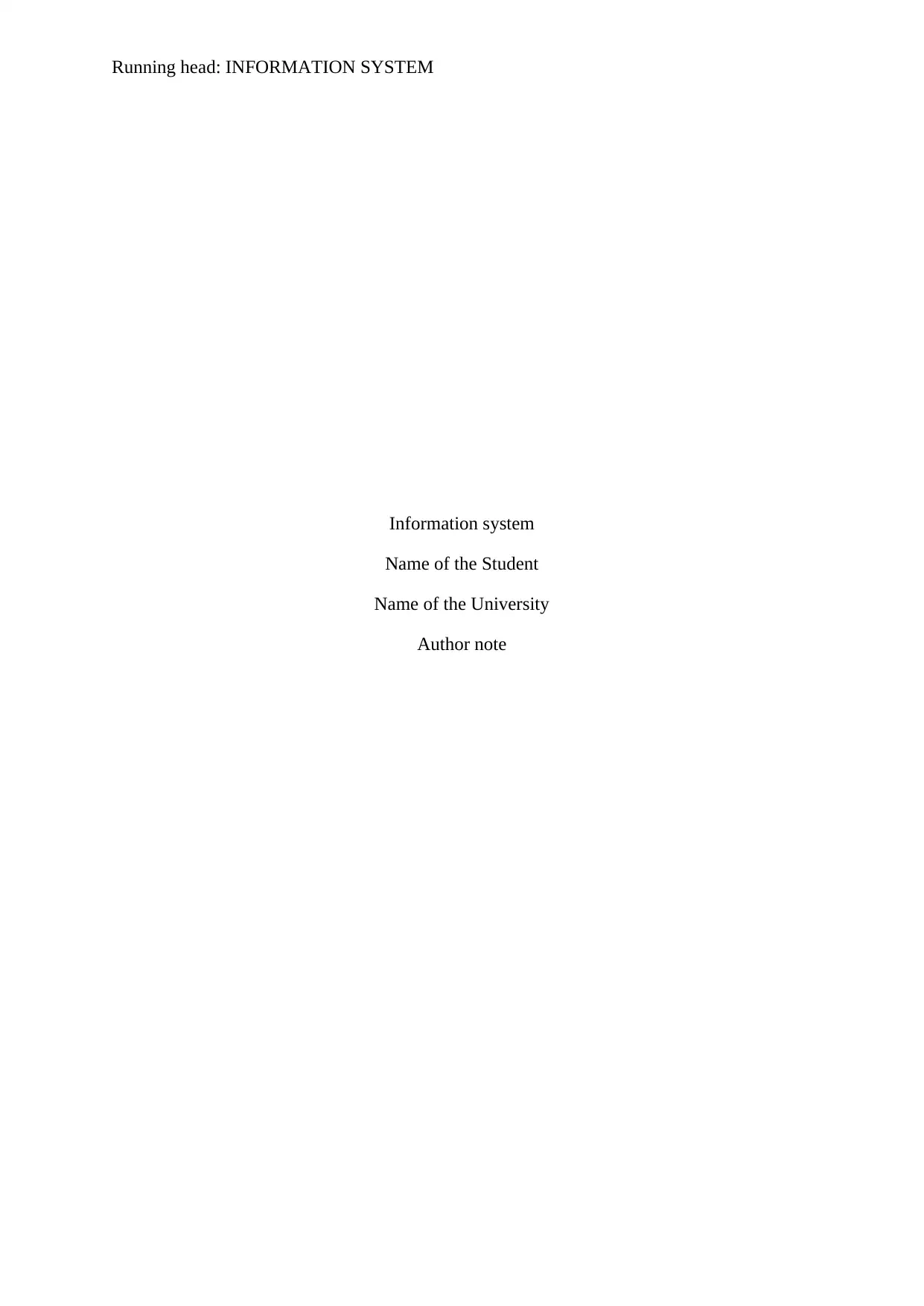
Running head: INFORMATION SYSTEM
Information system
Name of the Student
Name of the University
Author note
Information system
Name of the Student
Name of the University
Author note
Secure Best Marks with AI Grader
Need help grading? Try our AI Grader for instant feedback on your assignments.
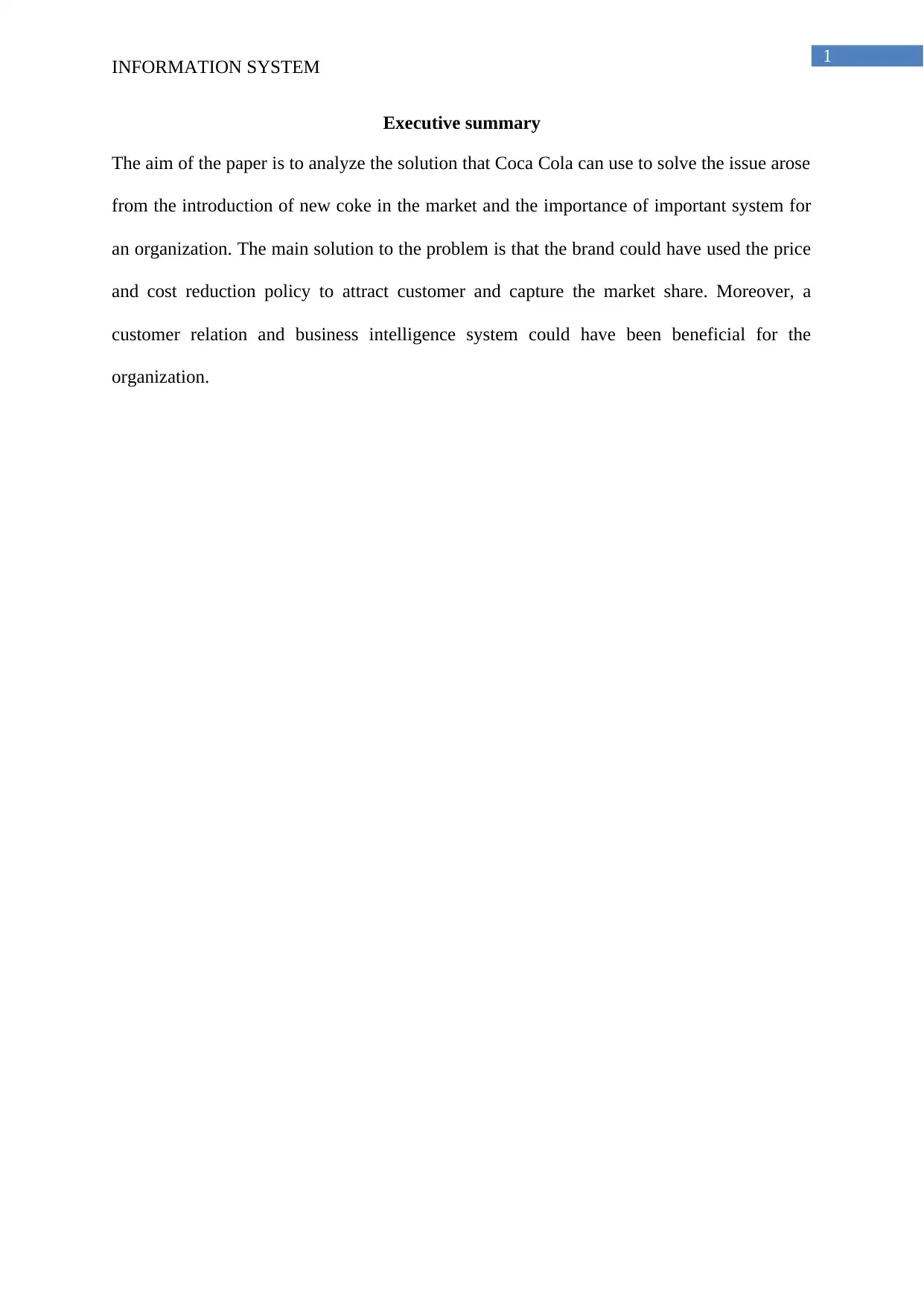
1
INFORMATION SYSTEM
Executive summary
The aim of the paper is to analyze the solution that Coca Cola can use to solve the issue arose
from the introduction of new coke in the market and the importance of important system for
an organization. The main solution to the problem is that the brand could have used the price
and cost reduction policy to attract customer and capture the market share. Moreover, a
customer relation and business intelligence system could have been beneficial for the
organization.
INFORMATION SYSTEM
Executive summary
The aim of the paper is to analyze the solution that Coca Cola can use to solve the issue arose
from the introduction of new coke in the market and the importance of important system for
an organization. The main solution to the problem is that the brand could have used the price
and cost reduction policy to attract customer and capture the market share. Moreover, a
customer relation and business intelligence system could have been beneficial for the
organization.
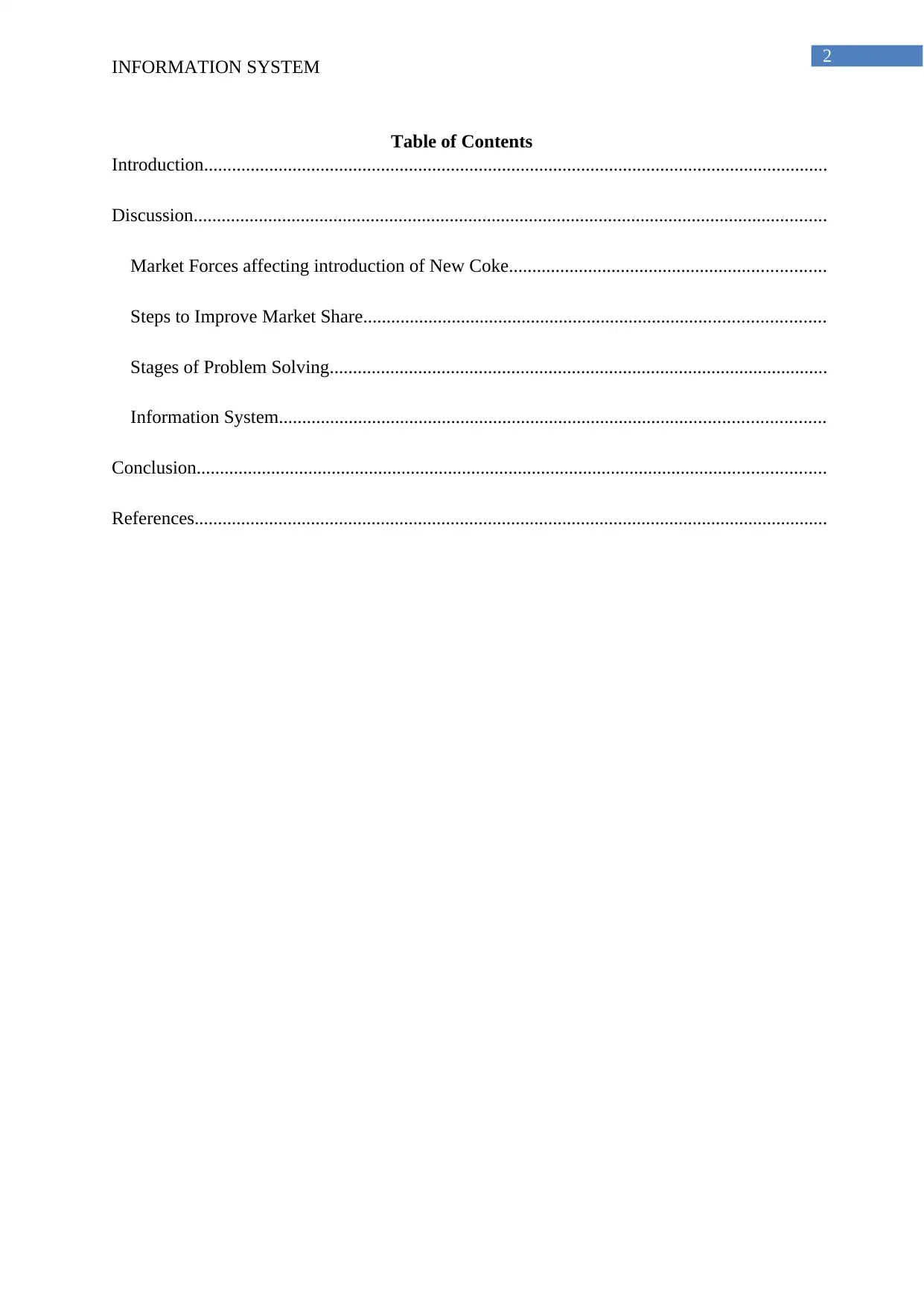
2
INFORMATION SYSTEM
Table of Contents
Introduction......................................................................................................................................
Discussion........................................................................................................................................
Market Forces affecting introduction of New Coke....................................................................
Steps to Improve Market Share...................................................................................................
Stages of Problem Solving...........................................................................................................
Information System.....................................................................................................................
Conclusion.......................................................................................................................................
References........................................................................................................................................
INFORMATION SYSTEM
Table of Contents
Introduction......................................................................................................................................
Discussion........................................................................................................................................
Market Forces affecting introduction of New Coke....................................................................
Steps to Improve Market Share...................................................................................................
Stages of Problem Solving...........................................................................................................
Information System.....................................................................................................................
Conclusion.......................................................................................................................................
References........................................................................................................................................
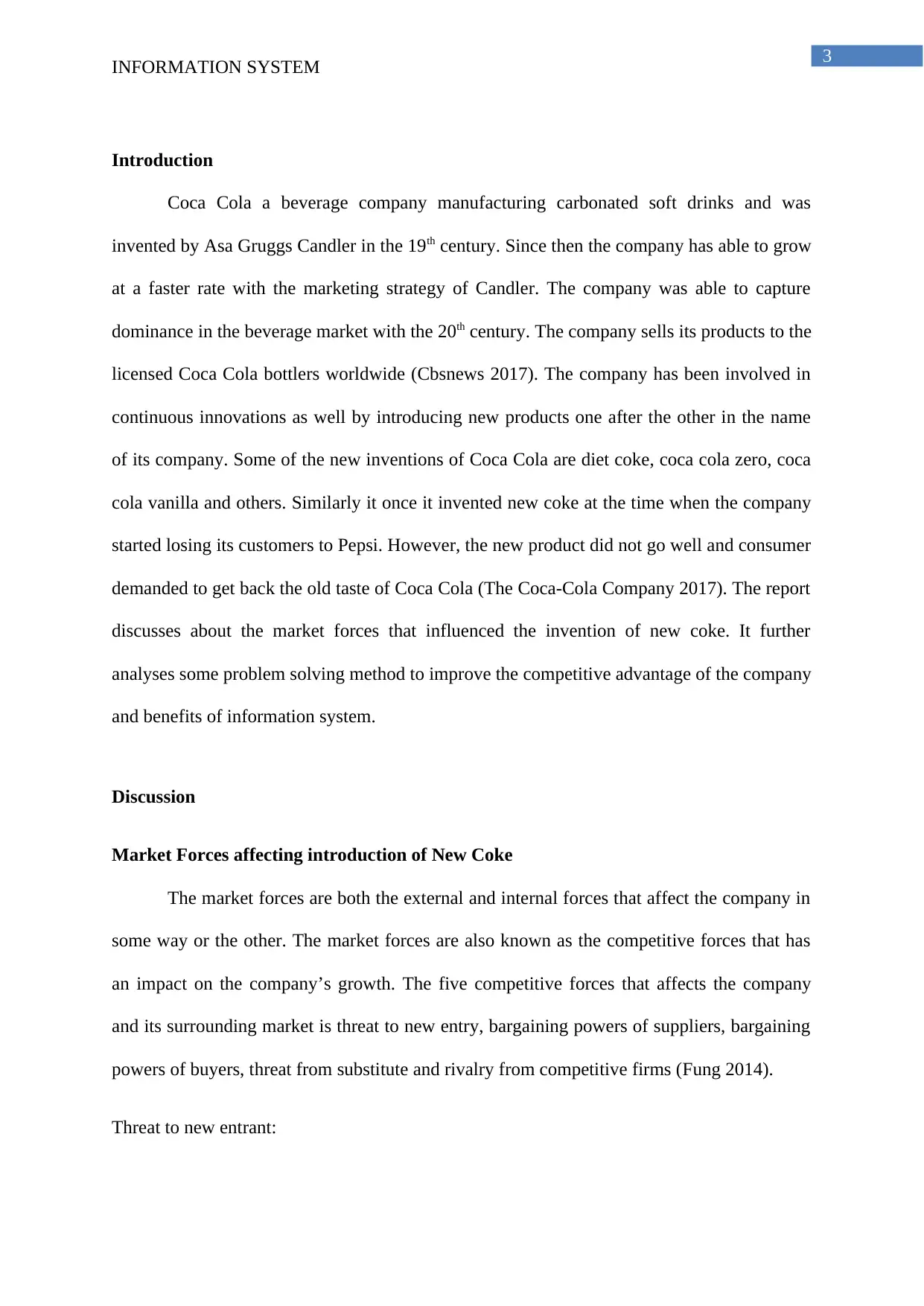
3
INFORMATION SYSTEM
Introduction
Coca Cola a beverage company manufacturing carbonated soft drinks and was
invented by Asa Gruggs Candler in the 19th century. Since then the company has able to grow
at a faster rate with the marketing strategy of Candler. The company was able to capture
dominance in the beverage market with the 20th century. The company sells its products to the
licensed Coca Cola bottlers worldwide (Cbsnews 2017). The company has been involved in
continuous innovations as well by introducing new products one after the other in the name
of its company. Some of the new inventions of Coca Cola are diet coke, coca cola zero, coca
cola vanilla and others. Similarly it once it invented new coke at the time when the company
started losing its customers to Pepsi. However, the new product did not go well and consumer
demanded to get back the old taste of Coca Cola (The Coca-Cola Company 2017). The report
discusses about the market forces that influenced the invention of new coke. It further
analyses some problem solving method to improve the competitive advantage of the company
and benefits of information system.
Discussion
Market Forces affecting introduction of New Coke
The market forces are both the external and internal forces that affect the company in
some way or the other. The market forces are also known as the competitive forces that has
an impact on the company’s growth. The five competitive forces that affects the company
and its surrounding market is threat to new entry, bargaining powers of suppliers, bargaining
powers of buyers, threat from substitute and rivalry from competitive firms (Fung 2014).
Threat to new entrant:
INFORMATION SYSTEM
Introduction
Coca Cola a beverage company manufacturing carbonated soft drinks and was
invented by Asa Gruggs Candler in the 19th century. Since then the company has able to grow
at a faster rate with the marketing strategy of Candler. The company was able to capture
dominance in the beverage market with the 20th century. The company sells its products to the
licensed Coca Cola bottlers worldwide (Cbsnews 2017). The company has been involved in
continuous innovations as well by introducing new products one after the other in the name
of its company. Some of the new inventions of Coca Cola are diet coke, coca cola zero, coca
cola vanilla and others. Similarly it once it invented new coke at the time when the company
started losing its customers to Pepsi. However, the new product did not go well and consumer
demanded to get back the old taste of Coca Cola (The Coca-Cola Company 2017). The report
discusses about the market forces that influenced the invention of new coke. It further
analyses some problem solving method to improve the competitive advantage of the company
and benefits of information system.
Discussion
Market Forces affecting introduction of New Coke
The market forces are both the external and internal forces that affect the company in
some way or the other. The market forces are also known as the competitive forces that has
an impact on the company’s growth. The five competitive forces that affects the company
and its surrounding market is threat to new entry, bargaining powers of suppliers, bargaining
powers of buyers, threat from substitute and rivalry from competitive firms (Fung 2014).
Threat to new entrant:
Secure Best Marks with AI Grader
Need help grading? Try our AI Grader for instant feedback on your assignments.
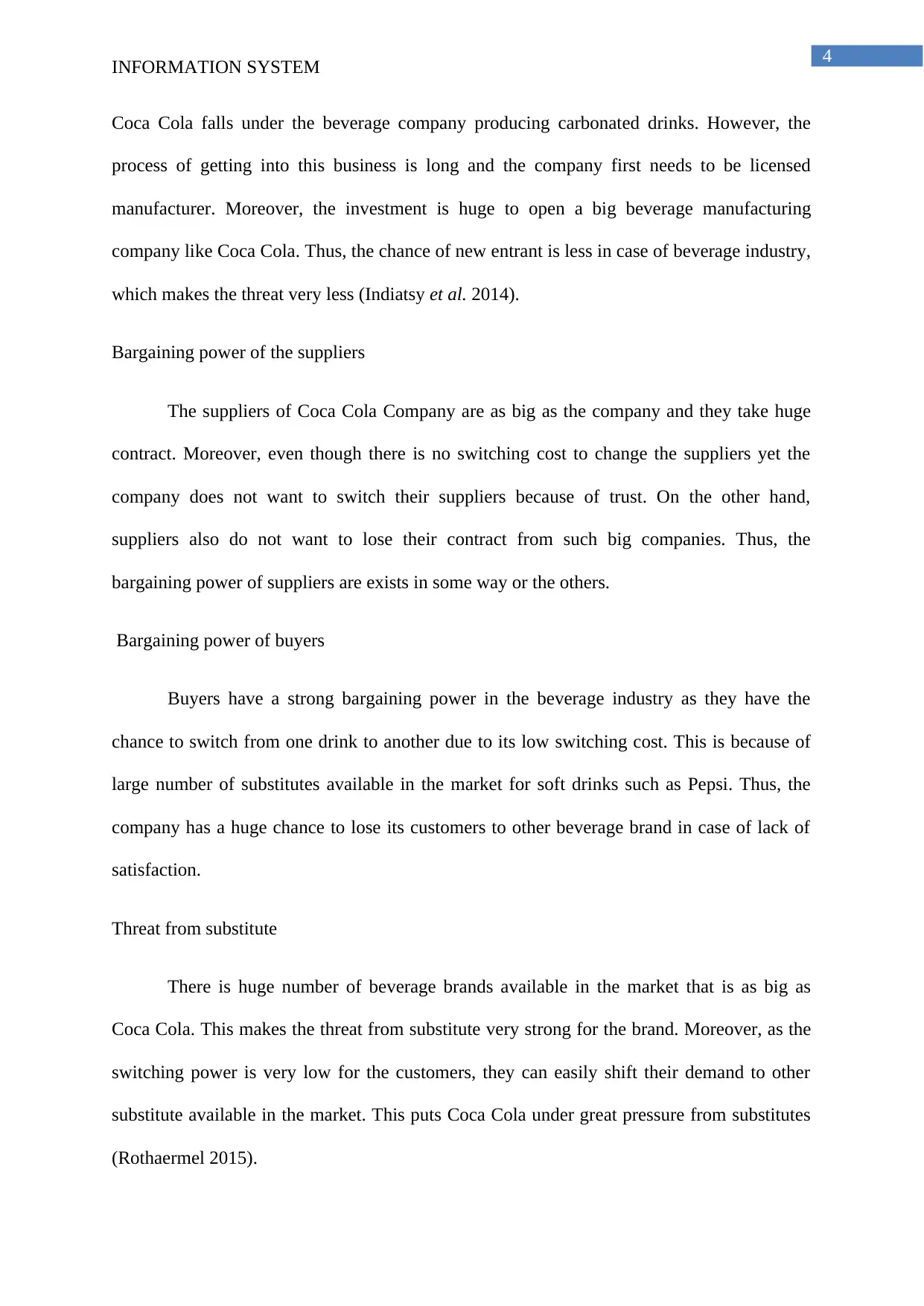
4
INFORMATION SYSTEM
Coca Cola falls under the beverage company producing carbonated drinks. However, the
process of getting into this business is long and the company first needs to be licensed
manufacturer. Moreover, the investment is huge to open a big beverage manufacturing
company like Coca Cola. Thus, the chance of new entrant is less in case of beverage industry,
which makes the threat very less (Indiatsy et al. 2014).
Bargaining power of the suppliers
The suppliers of Coca Cola Company are as big as the company and they take huge
contract. Moreover, even though there is no switching cost to change the suppliers yet the
company does not want to switch their suppliers because of trust. On the other hand,
suppliers also do not want to lose their contract from such big companies. Thus, the
bargaining power of suppliers are exists in some way or the others.
Bargaining power of buyers
Buyers have a strong bargaining power in the beverage industry as they have the
chance to switch from one drink to another due to its low switching cost. This is because of
large number of substitutes available in the market for soft drinks such as Pepsi. Thus, the
company has a huge chance to lose its customers to other beverage brand in case of lack of
satisfaction.
Threat from substitute
There is huge number of beverage brands available in the market that is as big as
Coca Cola. This makes the threat from substitute very strong for the brand. Moreover, as the
switching power is very low for the customers, they can easily shift their demand to other
substitute available in the market. This puts Coca Cola under great pressure from substitutes
(Rothaermel 2015).
INFORMATION SYSTEM
Coca Cola falls under the beverage company producing carbonated drinks. However, the
process of getting into this business is long and the company first needs to be licensed
manufacturer. Moreover, the investment is huge to open a big beverage manufacturing
company like Coca Cola. Thus, the chance of new entrant is less in case of beverage industry,
which makes the threat very less (Indiatsy et al. 2014).
Bargaining power of the suppliers
The suppliers of Coca Cola Company are as big as the company and they take huge
contract. Moreover, even though there is no switching cost to change the suppliers yet the
company does not want to switch their suppliers because of trust. On the other hand,
suppliers also do not want to lose their contract from such big companies. Thus, the
bargaining power of suppliers are exists in some way or the others.
Bargaining power of buyers
Buyers have a strong bargaining power in the beverage industry as they have the
chance to switch from one drink to another due to its low switching cost. This is because of
large number of substitutes available in the market for soft drinks such as Pepsi. Thus, the
company has a huge chance to lose its customers to other beverage brand in case of lack of
satisfaction.
Threat from substitute
There is huge number of beverage brands available in the market that is as big as
Coca Cola. This makes the threat from substitute very strong for the brand. Moreover, as the
switching power is very low for the customers, they can easily shift their demand to other
substitute available in the market. This puts Coca Cola under great pressure from substitutes
(Rothaermel 2015).
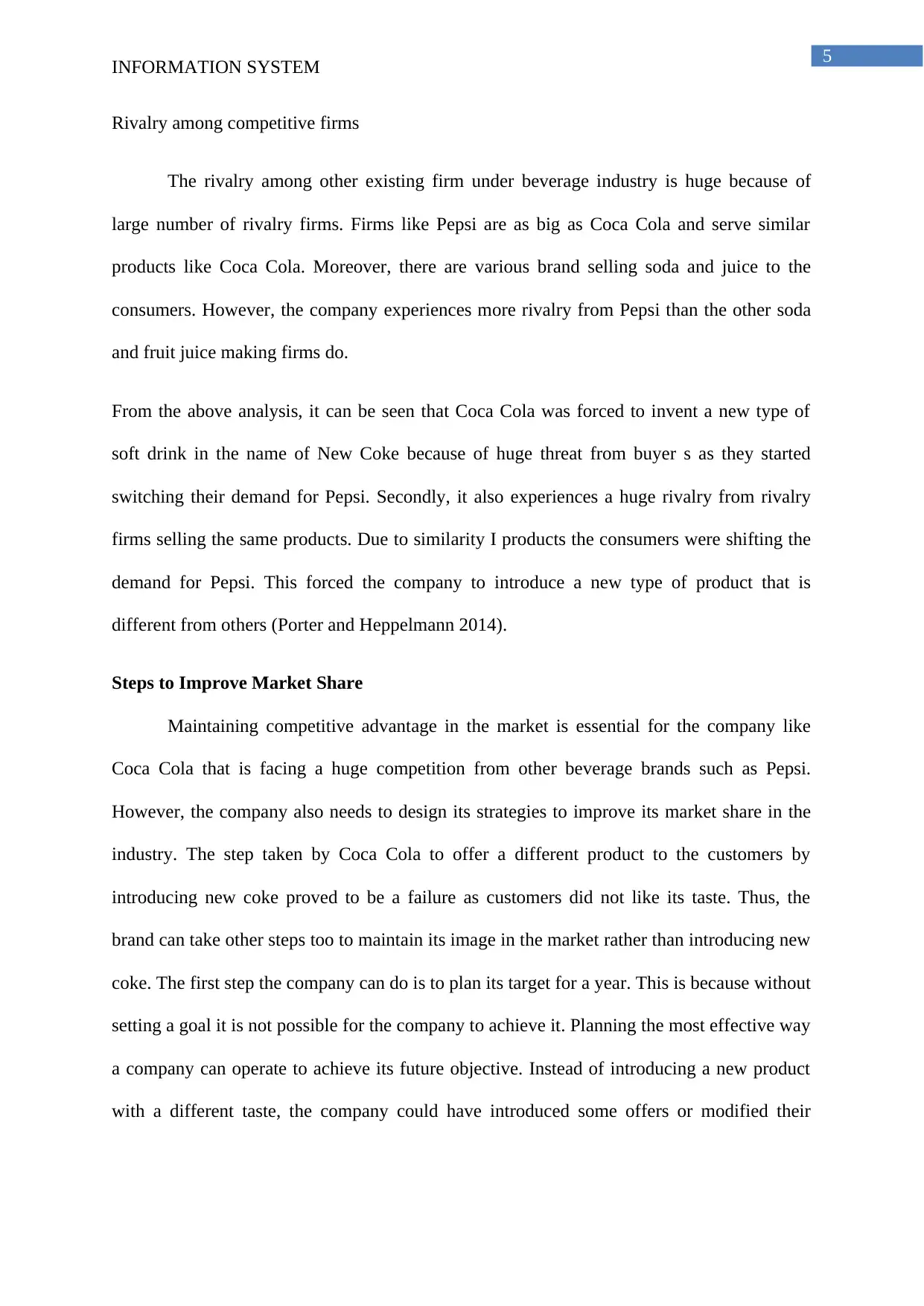
5
INFORMATION SYSTEM
Rivalry among competitive firms
The rivalry among other existing firm under beverage industry is huge because of
large number of rivalry firms. Firms like Pepsi are as big as Coca Cola and serve similar
products like Coca Cola. Moreover, there are various brand selling soda and juice to the
consumers. However, the company experiences more rivalry from Pepsi than the other soda
and fruit juice making firms do.
From the above analysis, it can be seen that Coca Cola was forced to invent a new type of
soft drink in the name of New Coke because of huge threat from buyer s as they started
switching their demand for Pepsi. Secondly, it also experiences a huge rivalry from rivalry
firms selling the same products. Due to similarity I products the consumers were shifting the
demand for Pepsi. This forced the company to introduce a new type of product that is
different from others (Porter and Heppelmann 2014).
Steps to Improve Market Share
Maintaining competitive advantage in the market is essential for the company like
Coca Cola that is facing a huge competition from other beverage brands such as Pepsi.
However, the company also needs to design its strategies to improve its market share in the
industry. The step taken by Coca Cola to offer a different product to the customers by
introducing new coke proved to be a failure as customers did not like its taste. Thus, the
brand can take other steps too to maintain its image in the market rather than introducing new
coke. The first step the company can do is to plan its target for a year. This is because without
setting a goal it is not possible for the company to achieve it. Planning the most effective way
a company can operate to achieve its future objective. Instead of introducing a new product
with a different taste, the company could have introduced some offers or modified their
INFORMATION SYSTEM
Rivalry among competitive firms
The rivalry among other existing firm under beverage industry is huge because of
large number of rivalry firms. Firms like Pepsi are as big as Coca Cola and serve similar
products like Coca Cola. Moreover, there are various brand selling soda and juice to the
consumers. However, the company experiences more rivalry from Pepsi than the other soda
and fruit juice making firms do.
From the above analysis, it can be seen that Coca Cola was forced to invent a new type of
soft drink in the name of New Coke because of huge threat from buyer s as they started
switching their demand for Pepsi. Secondly, it also experiences a huge rivalry from rivalry
firms selling the same products. Due to similarity I products the consumers were shifting the
demand for Pepsi. This forced the company to introduce a new type of product that is
different from others (Porter and Heppelmann 2014).
Steps to Improve Market Share
Maintaining competitive advantage in the market is essential for the company like
Coca Cola that is facing a huge competition from other beverage brands such as Pepsi.
However, the company also needs to design its strategies to improve its market share in the
industry. The step taken by Coca Cola to offer a different product to the customers by
introducing new coke proved to be a failure as customers did not like its taste. Thus, the
brand can take other steps too to maintain its image in the market rather than introducing new
coke. The first step the company can do is to plan its target for a year. This is because without
setting a goal it is not possible for the company to achieve it. Planning the most effective way
a company can operate to achieve its future objective. Instead of introducing a new product
with a different taste, the company could have introduced some offers or modified their

6
INFORMATION SYSTEM
pricing strategy for their existing drinks. This could have motivated the customers to buy
Coca Cola instead of other drinks (Xu and Lui 2016).
Secondly, the company could have first introduced a sample of new coke and
conducted some research about the acceptance rate of this drink before just launching it. The
company could have carried out campaign targeting the youth, as they are the maximum
consumers of soft drink. In the campaign, the company could have introduced the sample of
the drink to the youths to see its acceptance rate and could have saved itself from loss.
Thirdly, instead of introducing new coke it could have introduced some kind of fruit juice in
its brand. This is because people nowadays are becoming very health conscious and a fruit
juice rather than carbonated drink could have increased the acceptance rate compared to new
coke. Moreover, it could have given a tough competition to companies selling fruit juice and
could have gained a comparative advantage by selling all-purpose drink under them
(Daneshgari et al. 2016). The alternative steps that the company should have taken instead of
introducing new coke in the market. This is because the customers did not accept their new
coke taste and it might prove to be more detrimental for the company’s growth. Thus, the
company needs to accept these alternative steps to expand its market share in the world.
Stages of Problem Solving
The failure of new coke in the market raised a concern among the managers to take
some problem solving steps to resolve the risk arising from it. There are various steps
involving the problem solving procedure such a identifying the problem, provide solution,
pick on solution, and implement the solution and reviewing of result. Problems are critical for
the success of a business and thus require to be solved as soon as possible with the help of
these steps. Initial step is to identify the problem such as in this case is the failure of Coca
Cola to expand its market share through new coke. The next step is to offer solution for the
problem. The possible solution that Coca Cola could take to resolve the problem is to
INFORMATION SYSTEM
pricing strategy for their existing drinks. This could have motivated the customers to buy
Coca Cola instead of other drinks (Xu and Lui 2016).
Secondly, the company could have first introduced a sample of new coke and
conducted some research about the acceptance rate of this drink before just launching it. The
company could have carried out campaign targeting the youth, as they are the maximum
consumers of soft drink. In the campaign, the company could have introduced the sample of
the drink to the youths to see its acceptance rate and could have saved itself from loss.
Thirdly, instead of introducing new coke it could have introduced some kind of fruit juice in
its brand. This is because people nowadays are becoming very health conscious and a fruit
juice rather than carbonated drink could have increased the acceptance rate compared to new
coke. Moreover, it could have given a tough competition to companies selling fruit juice and
could have gained a comparative advantage by selling all-purpose drink under them
(Daneshgari et al. 2016). The alternative steps that the company should have taken instead of
introducing new coke in the market. This is because the customers did not accept their new
coke taste and it might prove to be more detrimental for the company’s growth. Thus, the
company needs to accept these alternative steps to expand its market share in the world.
Stages of Problem Solving
The failure of new coke in the market raised a concern among the managers to take
some problem solving steps to resolve the risk arising from it. There are various steps
involving the problem solving procedure such a identifying the problem, provide solution,
pick on solution, and implement the solution and reviewing of result. Problems are critical for
the success of a business and thus require to be solved as soon as possible with the help of
these steps. Initial step is to identify the problem such as in this case is the failure of Coca
Cola to expand its market share through new coke. The next step is to offer solution for the
problem. The possible solution that Coca Cola could take to resolve the problem is to
Paraphrase This Document
Need a fresh take? Get an instant paraphrase of this document with our AI Paraphraser
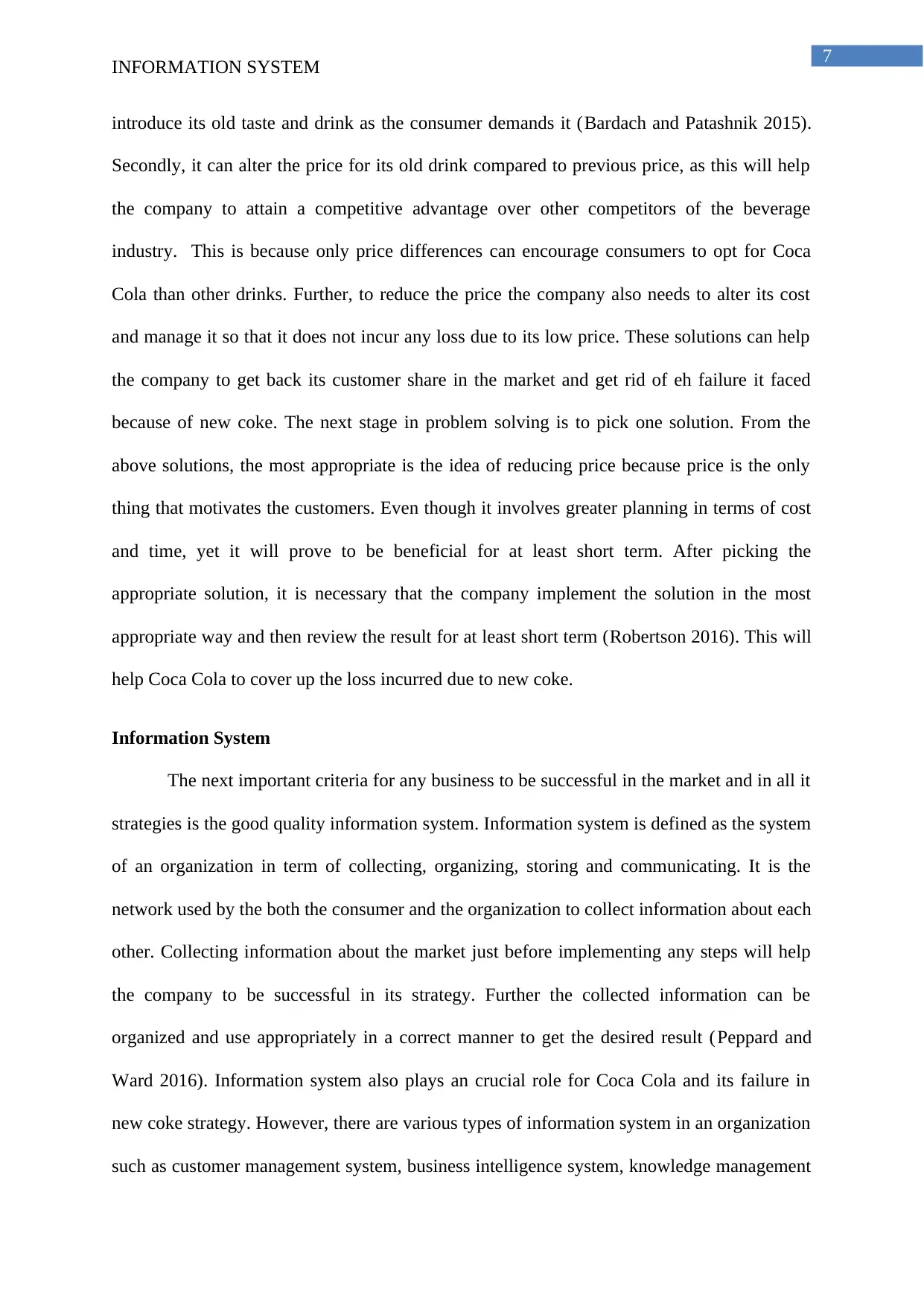
7
INFORMATION SYSTEM
introduce its old taste and drink as the consumer demands it (Bardach and Patashnik 2015).
Secondly, it can alter the price for its old drink compared to previous price, as this will help
the company to attain a competitive advantage over other competitors of the beverage
industry. This is because only price differences can encourage consumers to opt for Coca
Cola than other drinks. Further, to reduce the price the company also needs to alter its cost
and manage it so that it does not incur any loss due to its low price. These solutions can help
the company to get back its customer share in the market and get rid of eh failure it faced
because of new coke. The next stage in problem solving is to pick one solution. From the
above solutions, the most appropriate is the idea of reducing price because price is the only
thing that motivates the customers. Even though it involves greater planning in terms of cost
and time, yet it will prove to be beneficial for at least short term. After picking the
appropriate solution, it is necessary that the company implement the solution in the most
appropriate way and then review the result for at least short term (Robertson 2016). This will
help Coca Cola to cover up the loss incurred due to new coke.
Information System
The next important criteria for any business to be successful in the market and in all it
strategies is the good quality information system. Information system is defined as the system
of an organization in term of collecting, organizing, storing and communicating. It is the
network used by the both the consumer and the organization to collect information about each
other. Collecting information about the market just before implementing any steps will help
the company to be successful in its strategy. Further the collected information can be
organized and use appropriately in a correct manner to get the desired result (Peppard and
Ward 2016). Information system also plays an crucial role for Coca Cola and its failure in
new coke strategy. However, there are various types of information system in an organization
such as customer management system, business intelligence system, knowledge management
INFORMATION SYSTEM
introduce its old taste and drink as the consumer demands it (Bardach and Patashnik 2015).
Secondly, it can alter the price for its old drink compared to previous price, as this will help
the company to attain a competitive advantage over other competitors of the beverage
industry. This is because only price differences can encourage consumers to opt for Coca
Cola than other drinks. Further, to reduce the price the company also needs to alter its cost
and manage it so that it does not incur any loss due to its low price. These solutions can help
the company to get back its customer share in the market and get rid of eh failure it faced
because of new coke. The next stage in problem solving is to pick one solution. From the
above solutions, the most appropriate is the idea of reducing price because price is the only
thing that motivates the customers. Even though it involves greater planning in terms of cost
and time, yet it will prove to be beneficial for at least short term. After picking the
appropriate solution, it is necessary that the company implement the solution in the most
appropriate way and then review the result for at least short term (Robertson 2016). This will
help Coca Cola to cover up the loss incurred due to new coke.
Information System
The next important criteria for any business to be successful in the market and in all it
strategies is the good quality information system. Information system is defined as the system
of an organization in term of collecting, organizing, storing and communicating. It is the
network used by the both the consumer and the organization to collect information about each
other. Collecting information about the market just before implementing any steps will help
the company to be successful in its strategy. Further the collected information can be
organized and use appropriately in a correct manner to get the desired result (Peppard and
Ward 2016). Information system also plays an crucial role for Coca Cola and its failure in
new coke strategy. However, there are various types of information system in an organization
such as customer management system, business intelligence system, knowledge management
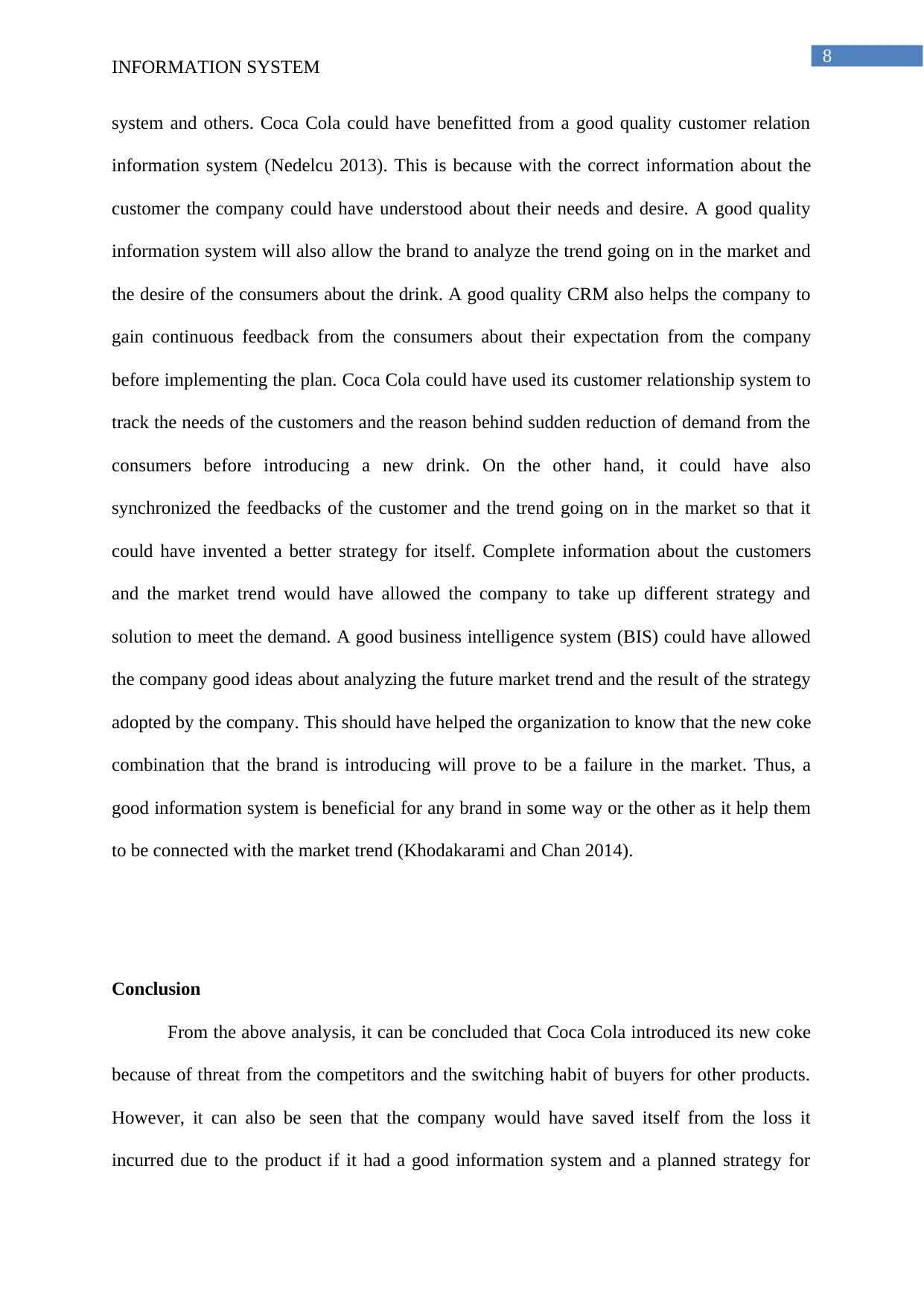
8
INFORMATION SYSTEM
system and others. Coca Cola could have benefitted from a good quality customer relation
information system (Nedelcu 2013). This is because with the correct information about the
customer the company could have understood about their needs and desire. A good quality
information system will also allow the brand to analyze the trend going on in the market and
the desire of the consumers about the drink. A good quality CRM also helps the company to
gain continuous feedback from the consumers about their expectation from the company
before implementing the plan. Coca Cola could have used its customer relationship system to
track the needs of the customers and the reason behind sudden reduction of demand from the
consumers before introducing a new drink. On the other hand, it could have also
synchronized the feedbacks of the customer and the trend going on in the market so that it
could have invented a better strategy for itself. Complete information about the customers
and the market trend would have allowed the company to take up different strategy and
solution to meet the demand. A good business intelligence system (BIS) could have allowed
the company good ideas about analyzing the future market trend and the result of the strategy
adopted by the company. This should have helped the organization to know that the new coke
combination that the brand is introducing will prove to be a failure in the market. Thus, a
good information system is beneficial for any brand in some way or the other as it help them
to be connected with the market trend (Khodakarami and Chan 2014).
Conclusion
From the above analysis, it can be concluded that Coca Cola introduced its new coke
because of threat from the competitors and the switching habit of buyers for other products.
However, it can also be seen that the company would have saved itself from the loss it
incurred due to the product if it had a good information system and a planned strategy for
INFORMATION SYSTEM
system and others. Coca Cola could have benefitted from a good quality customer relation
information system (Nedelcu 2013). This is because with the correct information about the
customer the company could have understood about their needs and desire. A good quality
information system will also allow the brand to analyze the trend going on in the market and
the desire of the consumers about the drink. A good quality CRM also helps the company to
gain continuous feedback from the consumers about their expectation from the company
before implementing the plan. Coca Cola could have used its customer relationship system to
track the needs of the customers and the reason behind sudden reduction of demand from the
consumers before introducing a new drink. On the other hand, it could have also
synchronized the feedbacks of the customer and the trend going on in the market so that it
could have invented a better strategy for itself. Complete information about the customers
and the market trend would have allowed the company to take up different strategy and
solution to meet the demand. A good business intelligence system (BIS) could have allowed
the company good ideas about analyzing the future market trend and the result of the strategy
adopted by the company. This should have helped the organization to know that the new coke
combination that the brand is introducing will prove to be a failure in the market. Thus, a
good information system is beneficial for any brand in some way or the other as it help them
to be connected with the market trend (Khodakarami and Chan 2014).
Conclusion
From the above analysis, it can be concluded that Coca Cola introduced its new coke
because of threat from the competitors and the switching habit of buyers for other products.
However, it can also be seen that the company would have saved itself from the loss it
incurred due to the product if it had a good information system and a planned strategy for
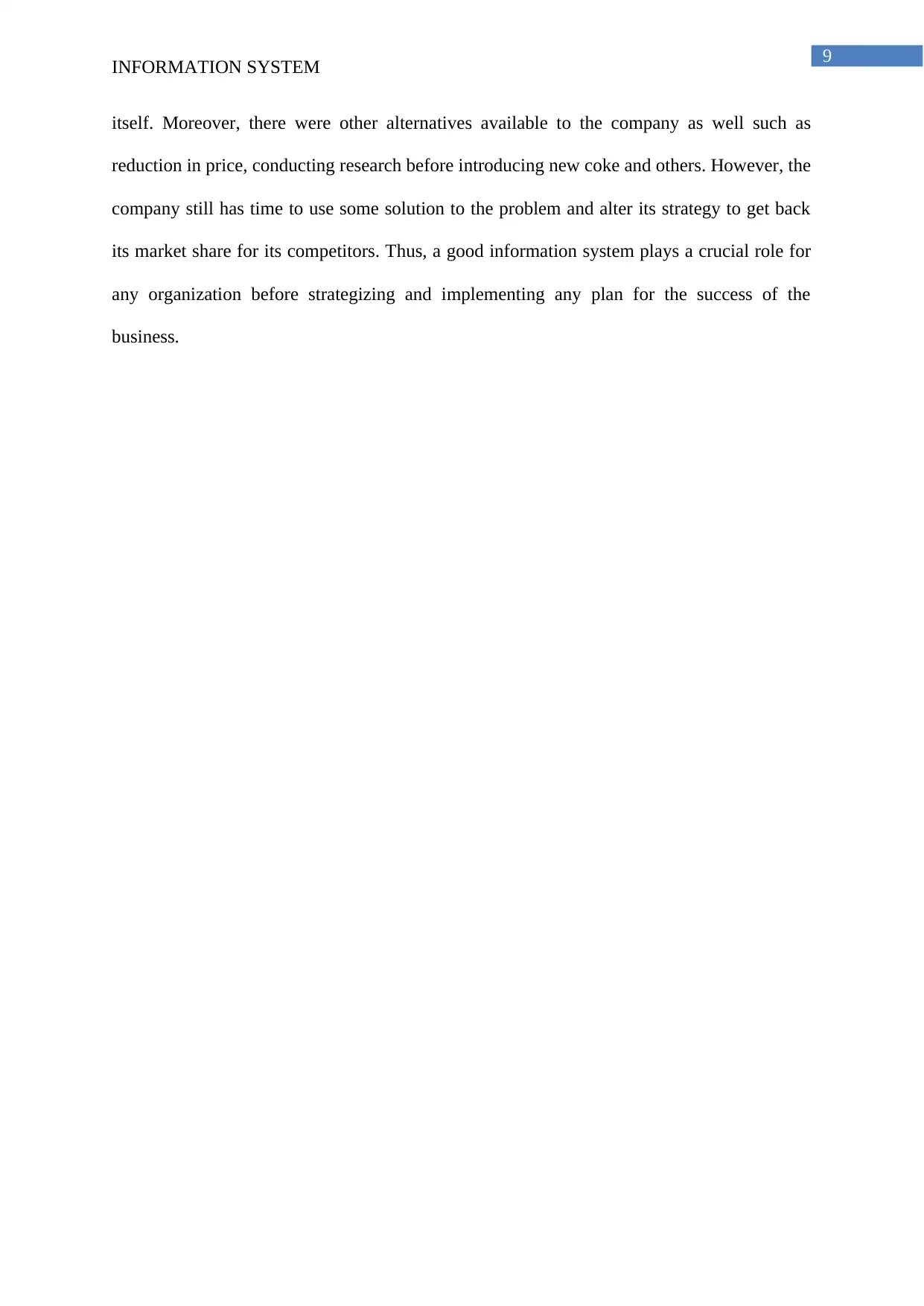
9
INFORMATION SYSTEM
itself. Moreover, there were other alternatives available to the company as well such as
reduction in price, conducting research before introducing new coke and others. However, the
company still has time to use some solution to the problem and alter its strategy to get back
its market share for its competitors. Thus, a good information system plays a crucial role for
any organization before strategizing and implementing any plan for the success of the
business.
INFORMATION SYSTEM
itself. Moreover, there were other alternatives available to the company as well such as
reduction in price, conducting research before introducing new coke and others. However, the
company still has time to use some solution to the problem and alter its strategy to get back
its market share for its competitors. Thus, a good information system plays a crucial role for
any organization before strategizing and implementing any plan for the success of the
business.
Secure Best Marks with AI Grader
Need help grading? Try our AI Grader for instant feedback on your assignments.
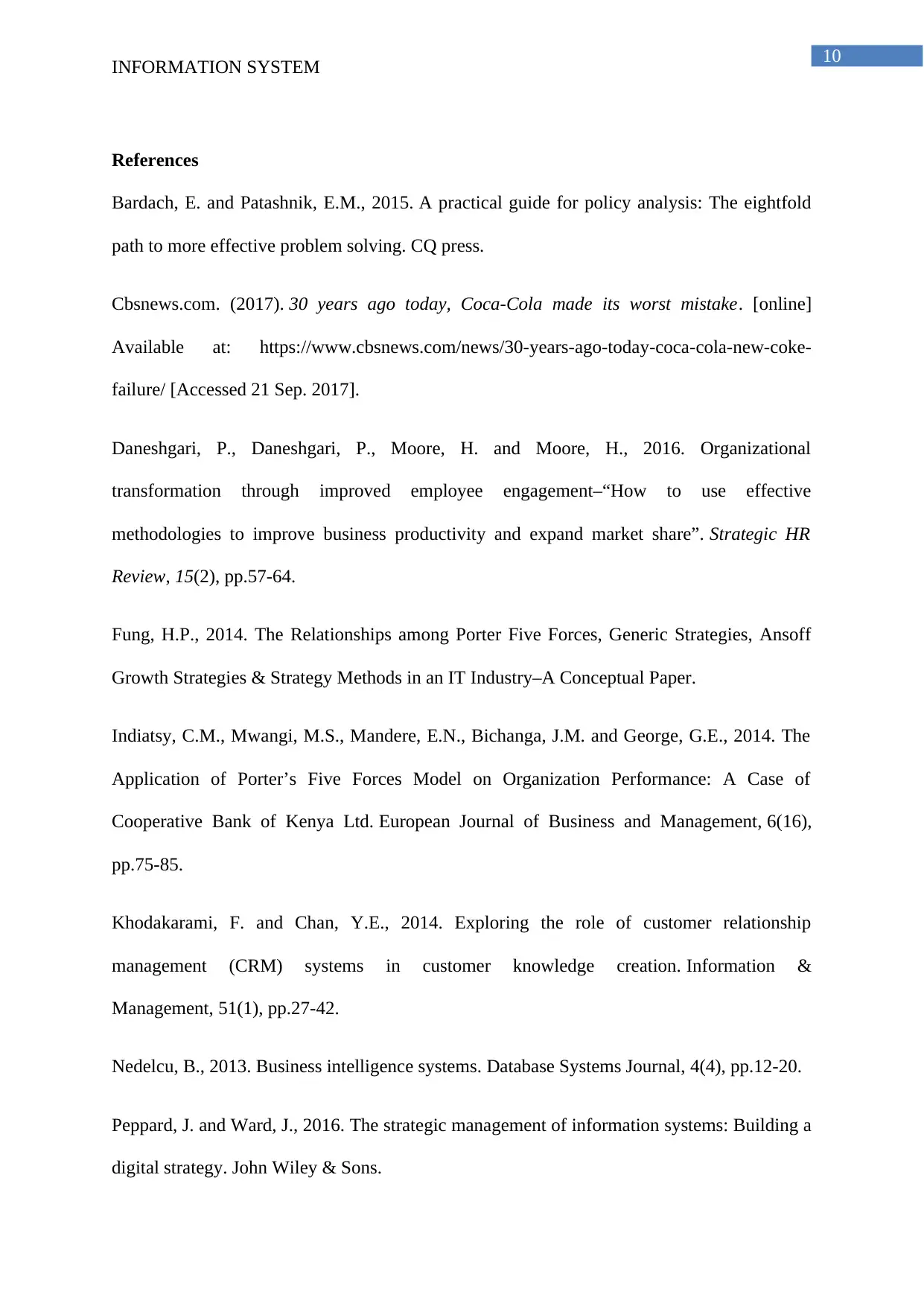
10
INFORMATION SYSTEM
References
Bardach, E. and Patashnik, E.M., 2015. A practical guide for policy analysis: The eightfold
path to more effective problem solving. CQ press.
Cbsnews.com. (2017). 30 years ago today, Coca-Cola made its worst mistake. [online]
Available at: https://www.cbsnews.com/news/30-years-ago-today-coca-cola-new-coke-
failure/ [Accessed 21 Sep. 2017].
Daneshgari, P., Daneshgari, P., Moore, H. and Moore, H., 2016. Organizational
transformation through improved employee engagement–“How to use effective
methodologies to improve business productivity and expand market share”. Strategic HR
Review, 15(2), pp.57-64.
Fung, H.P., 2014. The Relationships among Porter Five Forces, Generic Strategies, Ansoff
Growth Strategies & Strategy Methods in an IT Industry–A Conceptual Paper.
Indiatsy, C.M., Mwangi, M.S., Mandere, E.N., Bichanga, J.M. and George, G.E., 2014. The
Application of Porter’s Five Forces Model on Organization Performance: A Case of
Cooperative Bank of Kenya Ltd. European Journal of Business and Management, 6(16),
pp.75-85.
Khodakarami, F. and Chan, Y.E., 2014. Exploring the role of customer relationship
management (CRM) systems in customer knowledge creation. Information &
Management, 51(1), pp.27-42.
Nedelcu, B., 2013. Business intelligence systems. Database Systems Journal, 4(4), pp.12-20.
Peppard, J. and Ward, J., 2016. The strategic management of information systems: Building a
digital strategy. John Wiley & Sons.
INFORMATION SYSTEM
References
Bardach, E. and Patashnik, E.M., 2015. A practical guide for policy analysis: The eightfold
path to more effective problem solving. CQ press.
Cbsnews.com. (2017). 30 years ago today, Coca-Cola made its worst mistake. [online]
Available at: https://www.cbsnews.com/news/30-years-ago-today-coca-cola-new-coke-
failure/ [Accessed 21 Sep. 2017].
Daneshgari, P., Daneshgari, P., Moore, H. and Moore, H., 2016. Organizational
transformation through improved employee engagement–“How to use effective
methodologies to improve business productivity and expand market share”. Strategic HR
Review, 15(2), pp.57-64.
Fung, H.P., 2014. The Relationships among Porter Five Forces, Generic Strategies, Ansoff
Growth Strategies & Strategy Methods in an IT Industry–A Conceptual Paper.
Indiatsy, C.M., Mwangi, M.S., Mandere, E.N., Bichanga, J.M. and George, G.E., 2014. The
Application of Porter’s Five Forces Model on Organization Performance: A Case of
Cooperative Bank of Kenya Ltd. European Journal of Business and Management, 6(16),
pp.75-85.
Khodakarami, F. and Chan, Y.E., 2014. Exploring the role of customer relationship
management (CRM) systems in customer knowledge creation. Information &
Management, 51(1), pp.27-42.
Nedelcu, B., 2013. Business intelligence systems. Database Systems Journal, 4(4), pp.12-20.
Peppard, J. and Ward, J., 2016. The strategic management of information systems: Building a
digital strategy. John Wiley & Sons.
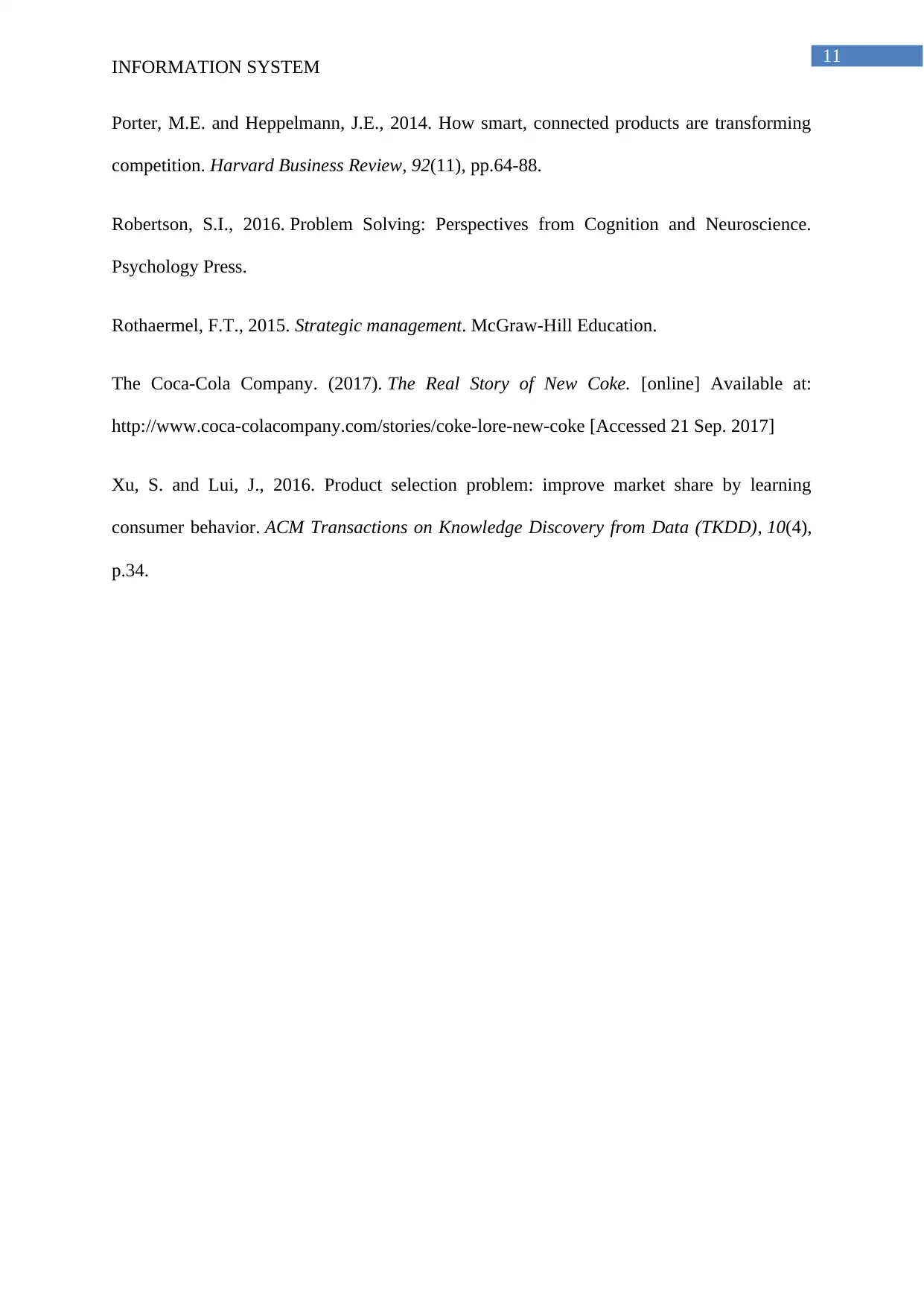
11
INFORMATION SYSTEM
Porter, M.E. and Heppelmann, J.E., 2014. How smart, connected products are transforming
competition. Harvard Business Review, 92(11), pp.64-88.
Robertson, S.I., 2016. Problem Solving: Perspectives from Cognition and Neuroscience.
Psychology Press.
Rothaermel, F.T., 2015. Strategic management. McGraw-Hill Education.
The Coca-Cola Company. (2017). The Real Story of New Coke. [online] Available at:
http://www.coca-colacompany.com/stories/coke-lore-new-coke [Accessed 21 Sep. 2017]
Xu, S. and Lui, J., 2016. Product selection problem: improve market share by learning
consumer behavior. ACM Transactions on Knowledge Discovery from Data (TKDD), 10(4),
p.34.
INFORMATION SYSTEM
Porter, M.E. and Heppelmann, J.E., 2014. How smart, connected products are transforming
competition. Harvard Business Review, 92(11), pp.64-88.
Robertson, S.I., 2016. Problem Solving: Perspectives from Cognition and Neuroscience.
Psychology Press.
Rothaermel, F.T., 2015. Strategic management. McGraw-Hill Education.
The Coca-Cola Company. (2017). The Real Story of New Coke. [online] Available at:
http://www.coca-colacompany.com/stories/coke-lore-new-coke [Accessed 21 Sep. 2017]
Xu, S. and Lui, J., 2016. Product selection problem: improve market share by learning
consumer behavior. ACM Transactions on Knowledge Discovery from Data (TKDD), 10(4),
p.34.
1 out of 12
Related Documents
Your All-in-One AI-Powered Toolkit for Academic Success.
+13062052269
info@desklib.com
Available 24*7 on WhatsApp / Email
![[object Object]](/_next/static/media/star-bottom.7253800d.svg)
Unlock your academic potential
© 2024 | Zucol Services PVT LTD | All rights reserved.




